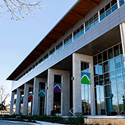Just Looking

Looking for more information about AlamoOPEN?
Take in a deeper look into the world of OER and what it can do for students. Whether you're looking for a course or want to see peer reviewed publications, we have you covered.
If you are a student or an instructor you can search for AlamoOPEN and IM Direct Courses in the Schedule of Classes. You can choose to search by AlamoOPEN No-Cost Textbook and Alamo IM Direct Course to assist in your course search.
AlamoOPEN is the district’s No-Cost initiative, which includes the use Open Education Resources (OER) and other free resources: institutionally funded resources, such as library databases and or faculty original work that is used at no cost to the students. The focus for AlamoOPEN is a no cost experience for the student.
AlamoOPEN’s IM Direct is the district’s inclusive access initiative. Through this program the district is able to directly negotiate with publishers and other service provides to drive the cost of instructional material down. We are able to automatically include this reduced charge in tuition and fees saving time, money and better preparing our students for success in the classroom.
Allen, I., & Seaman, J. (2014). Opening the curriculum: Open educational resources in U.S. Higher Education, 2014. Retrieved from
Belikov, O., Bodily, R. (2016). Incentives and Barriers to OER Adoption: A Qualitative Analysis of Faculty Perceptions. Open Praxis, 8(3).
Bliss T., Robinson, T. J., Hilton, J., & Wiley, D. (2013). An OER COUP: College teacher and student perceptions of open educational resources. Journal of Interactive Media in Education, 2013(1). http://dx.doi.org/10.5334/2013-04
Fischer, L., Robinson, J., Hilton, J. & Wiley, D., (2015) A Multi-Institutional Study of the Impact of Open Textbook Adoption on the Learning Outcomes of Post-Secondary Students Journal of Computing in Higher Education, 27(3).
Robinson, J., Fischer, L., Wiley, D., & Hilton, J. (2014). The Impact of Open Textbooks on Secondary Science Learning Outcomes.Educational Researcher, 43(7).
Hilton, J., Robinson, J., Wiley, D., & Ackerman, J. (2014). Cost-Savings Achieved in Two Semesters Through the Adoption of Open Educational Resources. International Review of Research in Open and Distance Learning, 15(2).
Pawlyshyn, N., Bradlee, Casper L., & Miller, H. (2013). Adopting OER: A Case Study of Cross-Institutional Collaboration and Innovation. EDUCAUSE Review, November-December 2013.
Bliss, TJ., Hilton, J., Wiley, D., & Thanos, K. (2013). The Cost and Quality of Open Textbooks: Perceptions of Community College Faculty and Students. First Monday, 18(1).
Bliss, TJ, Robinson, J., Hilton, J., & Wiley, D. (2013). An OER COUP: College Teacher and Student Perceptions of Open Educational Resources. Journal of Interactive Media in Education.
Tonks, T., Weston, S., Wiley, D., & Barbour, M. (2013). “Opening” a New Kind of School: The Story of the Open High School of Utah. International Review of Research in Open and Distance Learning,14(1).
Feldstein, A., Martin, M., Hudson, A., Warren, K., Hilton, J., & Wiley, D. (2012). Open Textbooks and Increased Student Access and Outcomes. European Journal of Open, Distance and E-Learning.
Wiley, D., Hilton, J., Ellington, S. & Hall, T. (2012). A Preliminary Examination of the Cost Savings and Learning Impacts of Using Open Textbooks in Middle and High School Science Classes. International Review of Research in Open and Distance Learning, 13(3).
Hilton, J., Lutz, N., Wiley, D. (2012). Examining the reuse of open textbooks. International Review of Research in Open and Distance Learning, 13(2).
Johansen, J. & Wiley, D. (2011). A Sustainable Model for Opencourseware Development. Educational Technology Research & Development, 59(3).
Hilton, J., Wiley, D., Stein, J., Johnson, A. (2010). The Four R’s of Openness and ALMS Analysis: Frameworks for Open Educational Resources. Open Learning: The Journal of Open and Distance Learning
Wiley, D. & Hilton, J. (2009). Openness, Dynamic Specialization, and the Disaggregated Future of Higher Education. International Review of Research in Open and Distance Learning, 10(5).
Dissertations
Bliss, TJ. (2013). A Model of Digital Textbook Quality from the Perspective of College Students. Dissertation.
Gurell, S. (2012). Measuring the Technical Difficulty in Reusing Open Educational Resources with the ALMS Analysis Framework. Dissertation.
What is Creative Commons?
Creative Commons helps you legally share your knowledge and creativity to build a more equitable, accessible, and innovative world. We unlock the full potential of the internet to drive a new era of development, growth and productivity.
AlamoOPEN Trade Show information will be available soon.
When did the Open Education movement begin?
The term "open content" was coined in 1998 by David Wiley and was inspired by the open software movement. The prevalence of open educational resources and the community supporting them has been growing since.
What about quality?
Majority of OER are created by academics who are experts in their fields and are therefore optimally suited to judge a resource's quality.
What incentives an instructor to adopt or create a course in AlamoOPEN?
Alamo Colleges District fully supports all efforts to reduce the cost of instruction materials through either AlamoOPEN No-Cost or AlamoOPEN IM Direct. Student success is the primary focus for both programs.
What about copyright?
In order to be considered an OER the resource(s) must have an openly licensed. Please note authors of OER still retain full copyright of any artifact created.
What are Creative Commons Licenses?
Creative Commons Licenses are legal terms that supplement copyright –not an alternative to copyright. They work alongside copyright and enable the modification of its terms to fit specific needs. Applying a Creative Commons License to a work can be thought of as changing the familiar, "All rights reserved" to “Some rights reserved."
How do I register my work with a CC license?
You don't. To apply the terms of a CC license to a work and insert its icon and its attribution into your work where you would typically include "All Rights Reserved" or "©". You'll find an example declaration at the bottom of this page.






